- Home
- About
- Map
- Trips
- Bringing Boat West
- Migration West
- Solo Motorcycle Ride
- Final Family XC Trip
- Colorado Rockies
- Graduates' XC Trip
- Yosemite & Nevada
- Colorado & Utah
- Best of Utah
- Southern Loop
- Pacific Northwest
- Northern Loop
- Los Angeles to NYC
- East Coast Trips
- Martha's Vineyard
- 1 Week in Quebec
- Southeast Coast
- NH Backpacking
- Martha's Vineyard
- Canadian Maritimes
- Ocracoke Island
- Edisto Island
- First Landing '02
- Hunting Island '02
- Stowe in Winter
- Hunting Island '01
- Lake Placid
- Chesapeake
- Provincetown
- Hunting Island '00
- Acadia in Winter
- Boston Suburbs
- Niagara Falls
- First Landing '99
- Cape Hatteras
- West Coast Trips
- Burning Man
- Utah Off-Roading
- Maui
- Mojave 4WD Course
- Colorado River Rafting
- Bishop & Death Valley
- Kauai
- Yosemite Fall
- Utah Off-Road
- Lost Coast
- Yosemite Valley
- Arizona and New Mexico
- Pescadero & Capitola
- Bishop & Death Valley
- San Diego, Anza Borrego, Joshua Tree
- Carmel
- Death Valley in Fall
- Yosemite in the Fall
- Pacific Northwest
- Utah Off-Roading
- Southern CA Deserts
- Yosemite & Covid
- Lake Powell Covid
- Eastern Sierra & Covid
- Bishop & Death Valley
- Central & SE Oregon
- Mojave Road
- Eastern Sierra
- Trinity Alps
- Tuolumne Meadows
- Lake Powell Boating
- Eastern Sierra
- Yosemite Winter
- Hawaii
- 4WD Eastern Sierra
- 4WD Death Valley +
- Southern CA Deserts
- Christmas in Tahoe
- Yosemite & Pinnacles
- Totality
- Yosemite & Sierra
- Yosemite Christmas
- Yosemite, San Diego
- Yosemite & North CA
- Seattle to Sierra
- Southwest Deserts
- Yosemite & Sierra
- Pacific Northwest
- Yosemite & South CA
- Pacific Northwest
- Northern California
- Southern Alaska
- Vancouver Island
- International Trips
- Index
- Tips
- Books
- Photos/Videos
- Search
- Contact
Grand Staircase-Escalante Area, UT
Friday, September 15, 2023 - 3:30pm by Lolo
120 miles and 3 hours from our last stop - 2 night stay
Travelogue
Notom Bullfrog Road and the Burr Trail
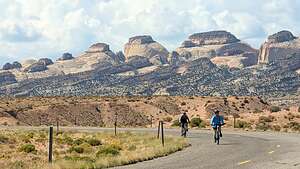 Along the Notom Bullfrog RoadAfter Cathedral Valley, we left the San Rafael Swell area and headed south along the Notom Bullfrog Road towards the Grand Staircase-Escalante National Monument area, another one of Utah’s many gems.
Along the Notom Bullfrog RoadAfter Cathedral Valley, we left the San Rafael Swell area and headed south along the Notom Bullfrog Road towards the Grand Staircase-Escalante National Monument area, another one of Utah’s many gems.
The Notom Bullfrog Road runs south from just west of Caineville through the lovely Strike Valley along the eastern boundary of Capitol Reef National Park, between the Henry Mountains and the Waterpocket Fold. It goes all the way to the Bullfrog Marina on Lake Powell, but we only went as far as the turnoff for the Burr Trail switchbacks.
The scenery along the way was so unique and beautiful that we stopped several times along the way. The ranches set against the base of the Waterpocket Fold provided a lovely juxtaposition of man-made and natural beauty.
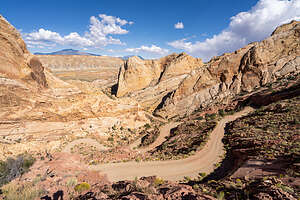 Burr Trail switchbacksAt 34 miles, we turned right towards Strike Valley and began our climb up the Burr Trail switchbacks, which although dirt, are doable in a 2WD car. However, they did climb 1,000 feet in a mile, so they were still pretty exciting. We stopped several times to gaze down at the tiny vehicles winding their way up the twists and turns of the switchbacks.
Burr Trail switchbacksAt 34 miles, we turned right towards Strike Valley and began our climb up the Burr Trail switchbacks, which although dirt, are doable in a 2WD car. However, they did climb 1,000 feet in a mile, so they were still pretty exciting. We stopped several times to gaze down at the tiny vehicles winding their way up the twists and turns of the switchbacks.
A short distance after the completion of the switchbacks, we came to the 3-mile spur road to the Strike Valley Overlook and the Upper Muley Twist trailhead. We did this hike in 2021 and it was absolutely incredible - probably one of the best hikes we have ever done. I highly recommend it. It is quite strenuous though - 10.7 miles with a 1,050 foot elevation gain, but the views along the way are worth every step of the way.
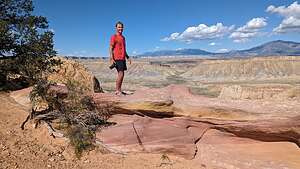 Atop the Burr Trail SwitchbacksBut we would pass on that today, as we had lots of stuff planned in the beautiful Grand Staircase-Escalante National Monument area.
Atop the Burr Trail SwitchbacksBut we would pass on that today, as we had lots of stuff planned in the beautiful Grand Staircase-Escalante National Monument area.
It was getting late in the afternoon though, so before venturing onto the Burr Trail, we decided to camp in the same spot we camped in 2021. This would allow us to enjoy the very scenic Burr Trail in morning light.
Since dispersed camping is not allowed in Capitol Reef National Park (or any national park), we drove a few miles past the Strike Valley Overlook turnoff until we hit asphalt, which told us we were now outside the boundaries of the Park, and camping was allowed. It wasn’t long before we found a nice spot in a pinyon forest.
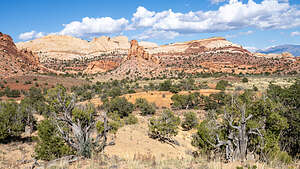 Along the Burr TrailIt was getting late in the afternoon though, so before venturing onto the Burr Trail, we decided to camp in the same spot we camped in 2021. This would allow us to enjoy the very scenic Burr Trail in morning light.
Along the Burr TrailIt was getting late in the afternoon though, so before venturing onto the Burr Trail, we decided to camp in the same spot we camped in 2021. This would allow us to enjoy the very scenic Burr Trail in morning light.
Since dispersed camping is not allowed in Capitol Reef National Park (or any national park), we drove a few miles past the Strike Valley Overlook turnoff until we hit asphalt, which told us we were now outside the boundaries of the Park and on BLM land where camping is allowed.
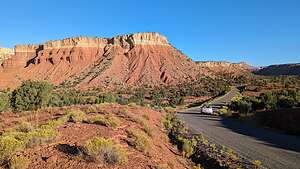 Along the Burr TrailThen we made a right turn into a lovely pinyon forest. The last time we were here, we could drive pretty far into the forest, but so many trees were down that we could get too far. However, we did find a nice spot to spend the night.
Along the Burr TrailThen we made a right turn into a lovely pinyon forest. The last time we were here, we could drive pretty far into the forest, but so many trees were down that we could get too far. However, we did find a nice spot to spend the night.
Herb cooked up his go-to camping meal - Bratwurst and powdered Idahoan potatoes. We counted the guacamole we had with our blue chips as our vegetable.
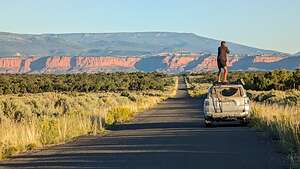 Along the Burr TrailThe next morning, we left the pinyon forest to start our drive along the Burr Trail. We had already done the most exciting part of it when we came up the Burr Trail Switchbacks yesterday, but there was still much great scenery to be had on the remaining 30 miles to the town of Boulder.
Along the Burr TrailThe next morning, we left the pinyon forest to start our drive along the Burr Trail. We had already done the most exciting part of it when we came up the Burr Trail Switchbacks yesterday, but there was still much great scenery to be had on the remaining 30 miles to the town of Boulder.
The Burr Trail used to be an old Mormon track used to bring livestock from the high-altitudes of Boulder to the warmer grazing areas of the Waterpocket Fold. The country is still wild and remote, but in the 1980s, the old trail was paved right up to the boundary of Capitol Reef. Today it is strictly used for recreational purposes, and there is nary a sign of a Mormon or a cattle herd to be seen.
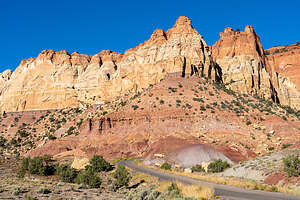 Along the Burr TrailThe nicest section of the drive is the last 10 miles or so through Long Canyon, which passes through sheer red sandstone cliffs covered with desert varnish.
Along the Burr TrailThe nicest section of the drive is the last 10 miles or so through Long Canyon, which passes through sheer red sandstone cliffs covered with desert varnish.
The Burr Trail ends at the intersection of Highway 12, one of the most scenic roads in America, especially the section between the towns of Boulder, where we were no, and Escalante, where we were headed.
At the intersection is the lovely Boulder Mountain Lodge where we would be staying tonight. I was so excited. We stayed here in 2021 and it was awesome. But first, a short drive down Scenic Byway 12 and a hike to the Lower Calf Creek Falls.
Lower Calf Creek Falls Hike
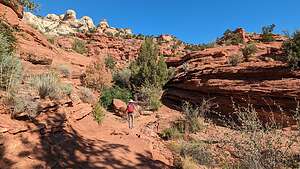 Heading out on the Lower Calf Creek Falls TrailHowever, we were too early to check in, so we drove 12 miles south on Highway 12 to the Lower Calf Creek Falls Trailhead, a hike I have wanted to do since we first came to Utah almost 20 years ago.
Heading out on the Lower Calf Creek Falls TrailHowever, we were too early to check in, so we drove 12 miles south on Highway 12 to the Lower Calf Creek Falls Trailhead, a hike I have wanted to do since we first came to Utah almost 20 years ago.
This is a very popular hike, so we were very lucky to get the last parking spot by the trailhead. In fact, it is considered by many to be the most rewarding short hike in Utah, which, if you’ve spent any time in Utah, is very high praise indeed.
We took one of the leaflets at the trailhead that had descriptions of various numbered stops along the way. We were most interested seeing the Rock Art at Stop #8.
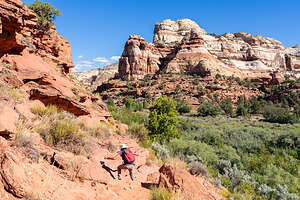 I want my trekking poles!The trail begins at the Lower Calf Creek Falls Campground and crosses a sandy stretch, before going up a side drainage, before dropping down some sandstone ledges to a few feet of the creek.
I want my trekking poles!The trail begins at the Lower Calf Creek Falls Campground and crosses a sandy stretch, before going up a side drainage, before dropping down some sandstone ledges to a few feet of the creek.
We were so distracted by the beautiful red Navajo Sandstone canyon we were in, that we forgot to look up high above on the canyon ledges where there were several granaries built by the ancient Fremont Culture that inhabited Utah from AD 700 to AD 1300 (#5 if we had been paying attention to our pamphlet).
.thumbnail.jpg) Lower Calf Creek FallsSometimes the trail got pretty rocky and I wished I had my trekking poles.
Lower Calf Creek FallsSometimes the trail got pretty rocky and I wished I had my trekking poles.
When we got to signpost #9, we realized we missed Stop #8 - the Pictographs, so we vowed to not miss them on the way back.
As we got nearer to the falls, the canyon narrowed and there was some welcome shade. The desert varnish on the canyon walls became even more noticeable - a nice contrast with the green of the tall grasses and the cottonwood trees.
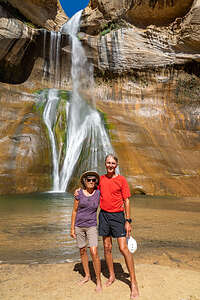 Lower Calf Creek FallsAnother thing that happened as we got closer to the falls were several people telling us that we were in for a real treat up ahead, which I assumed referred to the waterfall.
Lower Calf Creek FallsAnother thing that happened as we got closer to the falls were several people telling us that we were in for a real treat up ahead, which I assumed referred to the waterfall.
After crossing a small meadow, we arrived at the plunge pool where the 126-foot-high falls poured down the streaked, moss-covered wall. This was probably one of the prettiest falls I have ever seen, and we’ve seen a lot.
There were about a dozen or so people there hanging out on the nice sandy beach, politely taking their turns posing in front of the falls.
We must have stayed there enjoying the falls for over an hour before returning the way we came.
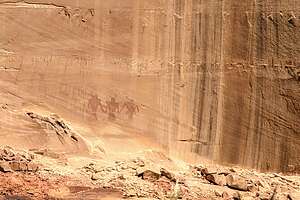 Fremont PictographDetermined to not miss the Pictographs again, we kept our eye out for Signpost #8. They were hard to find at first, but there they were, across the canyon at the base of a smooth cliff face streaked with desert varnish - three large, human-like figures painted with red pigment, wearing headdresses and holding hands.
Fremont PictographDetermined to not miss the Pictographs again, we kept our eye out for Signpost #8. They were hard to find at first, but there they were, across the canyon at the base of a smooth cliff face streaked with desert varnish - three large, human-like figures painted with red pigment, wearing headdresses and holding hands.
Their trapezoidal shape and elaborate headdresses are typical of Fromont-style rock art. They were probably created by the Fremont people, who lived in this area from about 700 – 1300 AD.
The entire hike was about 6-miles round-trip, with about a 530-foot elevation gain. It was worth every sandy, rocky step of the way.
Boulder Mountain Lodge and the Hell’s Backbone Grill
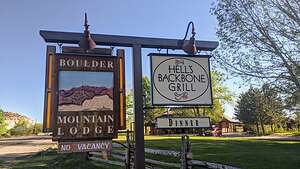 Boulder Mountain LodgeWe were very excited about returning to the Boulder Mountain Lodge, which we had discovered two years ago on a road trip to Utah.
Boulder Mountain LodgeWe were very excited about returning to the Boulder Mountain Lodge, which we had discovered two years ago on a road trip to Utah.
It is set in the middle of Utah’s red rock canyon country at the intersection of two of the most beautiful roads in Utah - the Burr Trail and Scenic Byway 12 - making it a perfect base camp for exploring the Grand Staircase-Escalante area.
Boulder Mountain Lodge is an unexpected oasis of tranquility and comfort, overlooking an 11-acre bird sanctuary. This nationally recognized luxury lodge provides everything for a fabulous getaway - spacious rooms, intimate ambiance, unparalleled views, fine dining, and an impressive array of services and amenities.
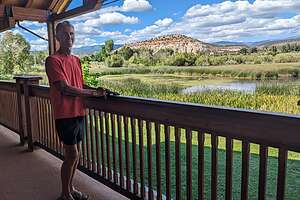 Our balcony at Boulder Mountain LodgeAfter so many nights of camping, it was like an oasis of comfort and tranquility. But first, I was very much looking forward to a shower.
Our balcony at Boulder Mountain LodgeAfter so many nights of camping, it was like an oasis of comfort and tranquility. But first, I was very much looking forward to a shower.
We were very lucky to have been able to reserve a room, because the Lodge is extremely popular and often books up years in advance. When I was still waffling back and forth about going on this trip with Herb so soon after our return from Vancouver Island, I went onto the Boulder Mountain Lodge website and checked availability for every day that we could possibly be here. There was only one night, and it was surprisingly for a Saturday, so I immediately booked it and the decision was finalized - I would accompany Herb on this spur of the moment Utah trip.
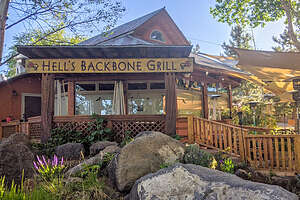 Dinner Time!We had Room #12 on the second floor of the main building with a balcony looking out over an 11-acre bird sanctuary. The very first act, after a shower of course, was sitting in the adirondack chairs on the balcony with a glass of wine.
Dinner Time!We had Room #12 on the second floor of the main building with a balcony looking out over an 11-acre bird sanctuary. The very first act, after a shower of course, was sitting in the adirondack chairs on the balcony with a glass of wine.
I also made dinner reservations for 7:15 at the award winning Hell’s Backbone Grill, located on the premises - a culinary experience not to be missed.
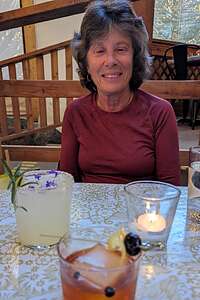 Lolo and her Hellfire MargaritaI was worried when I read that they had hired a new chef in March, because we really were impressed by the food the last time we were here. But no need to worry, as an award-winning chef named Tamara Stanger was taking over the kitchen, but still working with Jen Castle, and Blake Spalding, the two women that originally founded the restaurant over two decades ago.
Lolo and her Hellfire MargaritaI was worried when I read that they had hired a new chef in March, because we really were impressed by the food the last time we were here. But no need to worry, as an award-winning chef named Tamara Stanger was taking over the kitchen, but still working with Jen Castle, and Blake Spalding, the two women that originally founded the restaurant over two decades ago.
Sanger plans to continue following their Buddhist principles of commitment to sustainability, environmental ethics, and community responsibility. Much of their produce is grown on their six acre farm and their meat comes from local ranchers.
It was very hard to believe that we were in Utah, in the town of Boulder (population of 226), one of the most remote towns in America.
I had the Steelhead trout with rice and organic vegetables and a fancy Hellfire Margarita. Herb had a very large pork chop with mashed potatoes and organic vegetables plus a Highway 12 Old Fashion.
Needless to say, the food was delicious, the service impeccable, and the ambience lovely.
Tonight was certainly a contrast to our nights camping out in some very remote and beautiful places. However, Life is full of contrasts, and it is those contrasts that make things special. The totally different experiences of those nights in the wild and our cushy night tonight of fine dining enhanced our experience of each of them.
100 Hands Pictograph Panel
.thumbnail.jpg) 100 Hands Pictograph is up there somewhereTonight we had camping reservations at Kodachrome Basin Campground - another lucky grab before heading out on this trip, so we had the whole day to explore while driving south on beautiful Scenic Byway 12.
100 Hands Pictograph is up there somewhereTonight we had camping reservations at Kodachrome Basin Campground - another lucky grab before heading out on this trip, so we had the whole day to explore while driving south on beautiful Scenic Byway 12.
Our first stop was to see the 100 Hands Pictographs, located just above the Escalante River Trailhead, right along Highway 12.
From the parking area, we crossed the road and picked up the well-used social trail on the other side, which parallels the north property line of a private property. The pictographs are known to be a bit difficult to find, but that’s half the fun.
We could see the 100 Hands pictograph on the flat face of the large rock formation above us. Now we just had to get there. It did involve some scrambling over rock ledges to get to the base of the cliff.
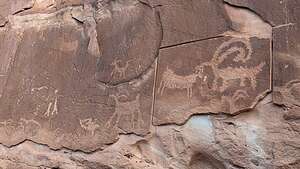 Bighorn Sheep panelThe first panel we came to was the Bighorn Sheep Panel. We were shocked to see that some vandals actually tried to saw the panels off the wall. No wonder some people frown upon disclosing the location of ancient pictographs and petroglyphs. There are too many idiots out there to do harm to these irreplaceable gems.
Bighorn Sheep panelThe first panel we came to was the Bighorn Sheep Panel. We were shocked to see that some vandals actually tried to saw the panels off the wall. No wonder some people frown upon disclosing the location of ancient pictographs and petroglyphs. There are too many idiots out there to do harm to these irreplaceable gems.
Actually, I think the Bighorn Sheep panel is a petroglyph, not a pictograph. The difference between a petroglyph and a pictograph is that a petroglyph is an image carved, incised or scratched into stone, while pictograph is a painting on stone, using natural pigments.
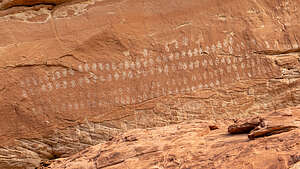 100 Hands PictographFrom there, we continued left along the cliff base constantly looking up for the 100 Hands Panel. It wasn’t too far before we found it, 30 feet above us on the cliff face. It was very cool. I wonder how the Fremont artists got up there to do this.
100 Hands PictographFrom there, we continued left along the cliff base constantly looking up for the 100 Hands Panel. It wasn’t too far before we found it, 30 feet above us on the cliff face. It was very cool. I wonder how the Fremont artists got up there to do this.
Unlike the Bighorn Sheep panel, this was a pictograph, because those hands were not carved but painted on using natural pigments, like the ones we saw on our hike to Lower Calf Creek falls yesterday.
After leaving, I realized I forgot to count them. I guess I could zoom in on the photo and count, but I’ll let it remain a mystery.
Devil's Garden along the Hole-in-the-Rock Road
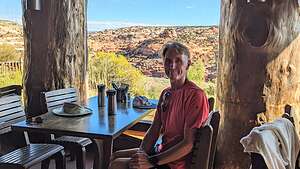 Herb at Kiva KoffeehouseOnce we clambered back down to our car, we drove less than a mile down the road to the Kiva Koffeehouse, a favorite stop of ours in the past.
Herb at Kiva KoffeehouseOnce we clambered back down to our car, we drove less than a mile down the road to the Kiva Koffeehouse, a favorite stop of ours in the past.
This is not just your ordinary coffee shop, but a work of art. This beautiful building was built in 1998 by Brasdshaw Bowman and his family. His vision was to create a beautiful building that blended harmoniously into the landscape of Southern Utah using natural building materials. Well, he succeeded and now people flock to this place, not just for the wonderful coffee and pastries, but to enjoy the incredible setting.
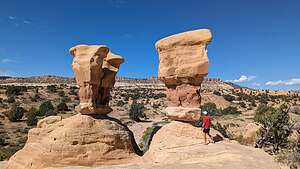 Devil's GardenWe sat there having our coffee overlooking the red and white striated sandstone rock formations that we had grown so accustomed to over the past week. Then we grabbed some sandwiches to go and headed back down Highway 12 for 9 miles, before turning right onto the Hole-in-the-Rock Road, a 106-mile (out-and-back) rough dirt road that starts near the town of Escalante and goes all the way to Lake Powell. Except for the last 7 miles, which gets very rough, it can usually be driven by high-clearance 2WD vehicles.
Devil's GardenWe sat there having our coffee overlooking the red and white striated sandstone rock formations that we had grown so accustomed to over the past week. Then we grabbed some sandwiches to go and headed back down Highway 12 for 9 miles, before turning right onto the Hole-in-the-Rock Road, a 106-mile (out-and-back) rough dirt road that starts near the town of Escalante and goes all the way to Lake Powell. Except for the last 7 miles, which gets very rough, it can usually be driven by high-clearance 2WD vehicles.
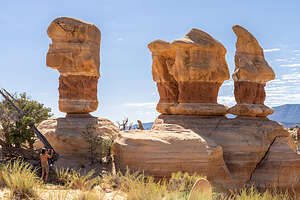 Devil's GardenIt's an historical trail that retraces the route taken in 1879 by a party of 230 Mormons, 83 wagons, and 1,000 cattle, who were sent out to build a settlement on the San Juan River.
Devil's GardenIt's an historical trail that retraces the route taken in 1879 by a party of 230 Mormons, 83 wagons, and 1,000 cattle, who were sent out to build a settlement on the San Juan River.
53-miles into what was already a rough journey, they came to the top of a cliff, with a narrow and steep crevice leading at a 25 to 45 degree angle down to what is now the Escalante Arm of Lake Powell 2,000 feet below. It wasn’t a lake then, but part of the Colorado River.
.thumbnail.jpg) Devil's GardenThat crevice became known as the Hole-in-the-Rock, and we have seen it from the water when boating in Lake Powell. Staring up at that steep crevice, I had a hard time imagining how they had accomplished this amazing feat. Trust me, you wouldn’t want to come down that, especially with wagons and cattle.
Devil's GardenThat crevice became known as the Hole-in-the-Rock, and we have seen it from the water when boating in Lake Powell. Staring up at that steep crevice, I had a hard time imagining how they had accomplished this amazing feat. Trust me, you wouldn’t want to come down that, especially with wagons and cattle.
The pioneers spent the entire winter working on the crack, slowly enlarging the opening with only pick axes, shovels, and small supplies of blasting powder.
Finally, on January 26, 1880, the expedition slowly made its way down the precarious “road” where a ferry had been built to get them across to the eastern side of the Colorado River where there was a route for them to continue on.
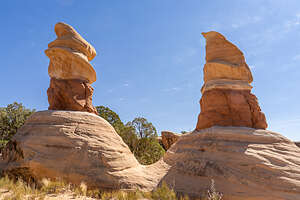 Devil's GardenUnbelievable. Never again will I complain about road conditions of any kind.
Devil's GardenUnbelievable. Never again will I complain about road conditions of any kind.
This is a road we very much wanted to do in its entirety someday (not the river crossing part), but for today we would have to satisfy ourselves with just the first 12 miles to get to the Devil’s Garden.
I felt kind of wimpy in our comfortable 4Runner, with the air conditioning going and sandwiches from Kiva Koffeehouse in our frig, driving just the first 12.5 miles of the road.
.thumbnail.jpg) Devil's GardenThe Devil’s Garden was pretty awesome, a wonderland of Navajo Sandstone hoodoos, domes, narrow passages and small arches, all in beige and brown, just ready to turn red in the golden hour. Instead we had to make due with the harsh late morning light, but it still was a delight to visit.
Devil's GardenThe Devil’s Garden was pretty awesome, a wonderland of Navajo Sandstone hoodoos, domes, narrow passages and small arches, all in beige and brown, just ready to turn red in the golden hour. Instead we had to make due with the harsh late morning light, but it still was a delight to visit.
There are no marked trails, so we just wandered around as we pleased, sometimes passing the same hoodoo several times. My favorite was the ones that looked like ice cream cones, or maybe I just thought that because it was so hot.
Definitely a worthwhile stop, and there are so many other beautiful places to see further along on the Hole-in-the-Rock Road. Maybe next time.
- ‹ previous
- 12 of 16
- next ›
Grand Staircase-Escalante Area location map in "high definition"
Javascript is required to view this map.
